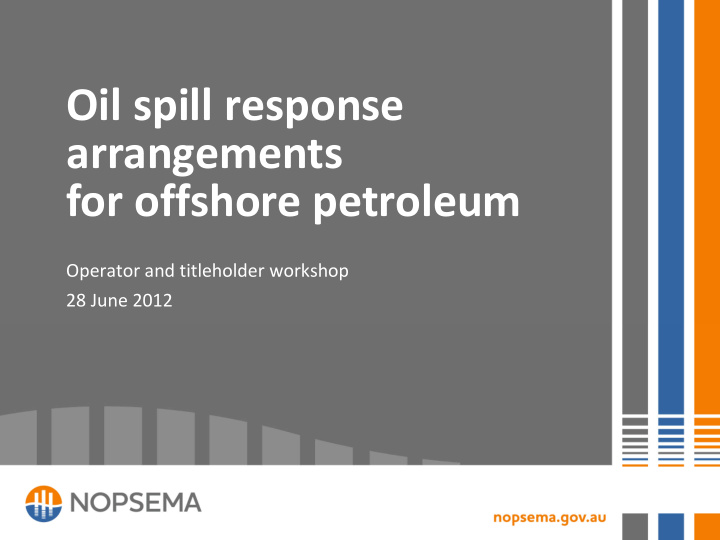



Oil spill response arrangements for offshore petroleum Operator and titleholder workshop 28 June 2012
Welcome to Alluvion Building • Evacuation – two tone alarm – Beep Beep = muster – Whoop whoop = evacuate down stairs • Facilities • Refreshments
Agenda 1:30pm Welcome and introduction Cameron Grebe GM Environment, NOPSEMA 1:45pm Workshop process Matt Smith overview Environment Manager, Spill Assessment 2:00pm Break-out sessions Participants 3:00pm Plenary session Participants 3:40pm Next steps Matt Smith Environment Manager, Spill Assessment
Summary of NOPSEMA activities 2012 to date • 60+ operator liaison meetings • Assessments – 87% accepted vs 13% refused – 98% assessments within timeframe (30 days) – 20 days average time for notification • Inspection program commenced • 5 industry workshops, Perth and Melbourne – Environment Plans, OSCP’s, Guidance Development • Guidance for spill preparedness and response – OSCP Preparation Guidance Note Revision 2 – Explanatory Note
Engagement program: tailored Regulatory and two-way communications Industry briefings Non Regulatory Other stakeholder briefings Key issues working External Opportunities Industry env mgt groups (Co-lead or workshop program participate) APPEA committees Input / review to and quarterly liaison APPEA guidelines and standards High level operator liaison Regulators fora (APRF, IRF, IOPER CEO delegation and AELERT) briefings Conference and The Regulator seminar newsletter participation Alerts NOPSEMA feedback/ complaints
Purpose & Expected outcomes • Identify and discuss areas of concern • Share learning and perspectives across industry • Provide feedback to NOPSEMA as Regulator and other agencies or responders within sector • NOPSEMA will commit to progressing improvement where possible • Identify areas of priority effort for NOPSEMA in development of additional guidance • Consolidate current industry view on oil spill preparedness and response • Communicate issues as appropriate
Break-out Session Process • 4 rooms, 4 focus areas, 60 minutes • White board and sticky notes • Discussion topics provided – guide only • Question sheet – guide only • Reference material • Summary sheet for Plenary session • 1 person /group nominated to give verbal presentation (approx. 10 mins) on focus area
Focus Areas • Response Framework Four topics. • Communication and Consultation in Response Four rooms. • Coordination of 60 minutes. Resources • Regulatory Matters
Focus Area A Response Framework and Responsibilities Division of Responsibility Duty Holder (title holder / operator) , Combat Agency Trans-boundary Spills Impacts Commonwealth, State, International Organisational & Response Structures Transitional Arrangements Escalation, effective response capability
Focus Area B Communication & Consultation in Response Consultation in preparation to respond Consultation during a response Responders, Stakeholders, Regulators Response communications and information management Role of Industry Advisor
Focus Area C Coordination of Resources Oil spill response training and competence Equipment availability - for multiple operators (more than one spill) Access to the oil spill response atlas (OSRA) Financial Arrangements - insurance & cost recovery, responders & stakeholders
Focus Area D Regulatory Matters EPBC Act Exemption NOPSEMA key functions during response – Assessment, Inspection, Investigation, Enforcement Significant Incident Directions
Discussion guide • Is enough information available on this topic, and where do we obtain this information? • Are arrangements clearly understood and do we have confidence in how they will be implemented in a response? • What additional information or clarification is necessary? • Why is this information so critical? • Do we have any specific ideas on how concerns could be addressed? • Who do we think leads this initiative? Are there other contributors?
Session Scope • In Scope – Preparedness and response arrangements. – Discussion guide and topic prompts are provided as a guide only. Other matters, within topic scope, can be discussed. • Out of Scope – Submission content, and assessment, of EP/OSCP. • Parking Lot – Important or contentious matters out of scope.
Plenary Session • Add new items to the priority list • Team presenter provides team summary • Free discussion on topics (10-15 minutes each) Priority Listing • 4 red dots per person • Dots indicate areas of critical concern, requiring focus and clarification in guidance • Applied to any item in any topic
Break-Out Sessions
Plenary Session
Next Steps • Issues collated and priorities identified – NOPSEMA will evaluate clarifications that are within jurisdiction and develop NOPSEMA action plan. – Clarifications that are within industry scope will be collated for participants, APPEA and/or AMOSC action. – Clarifications outside NOPSEMA jurisdiction will be communicated as appropriate. • Summary of workshop outcomes will be provided to participants within 4 weeks.
Thank you for your attendance and participation
Recommend
More recommend